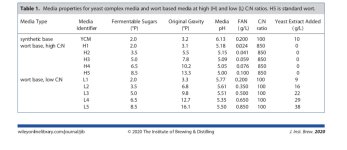Finn Berger
Brewer
- Joined
- Sep 13, 2022
- Messages
- 62
- Reaction score
- 33
The brülosophers have done a rather stunning exbeeriment on starters. Lower starter gravity to 1.008 to get rid of the Crabtree effect, and you'll be getting a lot more cells for you sugar - and not only that, you get yeast that do a better job . https://brulosophy.com/2022/10/24/exbeeriment-impact-yeast-starter-strength-has-on-a-munich-helles/
. https://brulosophy.com/2022/10/24/exbeeriment-impact-yeast-starter-strength-has-on-a-munich-helles/
Here's the study it is based on: https://onlinelibrary.wiley.com/doi/full/10.1002/jib.621
What seems important is using both enough yeast nutrient, and using the right kind. That means yeast extract based, not diammonium sulfate.
Here's the study it is based on: https://onlinelibrary.wiley.com/doi/full/10.1002/jib.621
What seems important is using both enough yeast nutrient, and using the right kind. That means yeast extract based, not diammonium sulfate.

